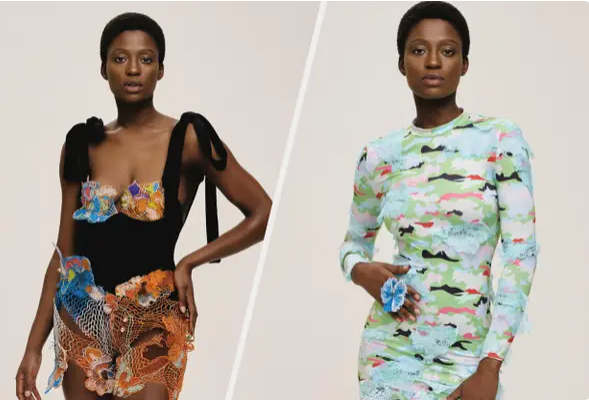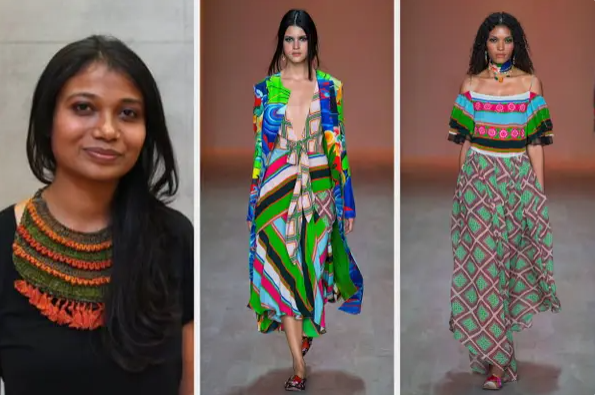Sustainable fashion designers have a key role to play in preventing climate change and ensuring zero-waste living because of the dangers conventional fashion poses to the environment.
The fashion industry has been catastrophic to environmental sustainability over the years. The company is regarded as one of the world’s largest polluters. In addition to pollution and waste its carbon footprint is too large.
Today, eco-fashion is no longer just the domain of niche designers but has become a huge, booming industry. Catwalks and boardrooms are now filled with sustainable and recyclable materials. Sustainable fashion designers are also now investing in earth-friendly baby products for a more eco-friendly household.
Who are Sustainable Fashion Designers?

According to Vogue, Sustainable fashion designers produce clothes that are friendly to the environment and the people who produce them. In addition to achieving goals like limiting CO2 emissions, maintaining a safe and healthy working environment, and compensating workers fairly, the concept also encompasses eco-friendly practices.
By applying eco-friendly techniques to diverse looks, sustainable fashion designers have demonstrated how fashion can be stylish and environmentally friendly at the same time.
Several core principles guide sustainable fashion designers, they include:
- Environmental sustainability: Reducing pollution, minimizing natural resource consumption, and selecting sustainably made materials
- Social equity: Maintaining safe and fair working conditions, supporting the rights of employees, and encouraging community involvement
- Circularity: Closed-loop systems minimize waste and maximize resource efficiency by designing for durability, recyclability, and upcycling
How Important are Sustainable Fashion Designers?

Sustainable fashion designers design clothing and accessories in a socially responsible, environmentally friendly, and economically feasible way. To positively impact the environment and society, the entire lifecycle of a garment should be considered and minimized, from sourcing raw materials to disposal.
As an example, the fashion industry in Australia contributes significantly to several environmental and social problems. Approximately 1.2% of the country’s greenhouse gas emissions come from the textile, clothing, and footwear industry, according to the Australian Bureau of Statistics. A significant portion of our fast fashion is made in developing countries, where poor working conditions are prevalent and workers are exploited.
In today’s fast fashion world, sustainable fashion designers offer the best solutions to the environmental and social problems of the fashion industry. Eco-friendly fashion minimizes negative impacts on society and the environment by considering the entire lifecycle of a clothing.
Sustainable fashion designers now take into account all aspects of the design’s lifecycle. All aspects of the lifecycle of our sustainable clothing are carefully monitored, from sourcing sustainably grown cotton to using low-carbon energy.
Unlike conventional fashion designers, sustainable fashion designers promote the use of ethical and sustainable practices, such as recycling and upcycling fabrics. By using environmentally friendly materials, reducing water and energy usage, and providing fair working conditions for workers, sustainable fashion is a viable option for the fashion and textile industries.
Sustainability in fashion is becoming increasingly important as people become more aware of environmental and social issues. Supporting sustainable fashion designers can make a difference in the future by consumers.
How Sustainable are Sustainable Fashion Designers?
Greenwashing is a major problem in the fashion industry. There is a growing demand among consumers for more eco-friendly products, which is why fashion brands use misleading terms like “organic” and “recycled” to describe their clothing brands.
In an attempt to appear more sustainable than it is, fast fashion companies tout recycling initiatives and launch ranges made from recycled materials. The Loop campaign by H&M is one example. Consumers will be able to recycle used clothing in-store starting in 2020, transforming old garments into new ones.
Although the recycling program reduces the environmental impact of its billions of garments, it doesn’t mitigate the impact of British retailer Asos’ circular collection and leading athleisure brand Lululemon’s sustainable revamp.
Major Sustainable Fashion Designers Influencing the Fashion Industry
As part of the slow fashion movement, these sustainable fashion designers use their platforms and brands to create pieces that are planet-friendly and made with materials that will last a long time.

There’s no doubt that Stella McCartney is one of the first names that come to mind when it comes to sustainable fashion designers. It has always been a priority for the designer to promote cruelty-free and mindful fashion since she founded her brand back in 2001. All of her designs are made of eco-friendly fabrics and she does not use leather or fur.
With its commitment to creating ethical and sustainable items since 2001, this luxurious fashion powerhouse has become a leader in the fashion world. Several organic and recycled materials are used by Stella McCartney, from slides made from industrial waste to trousers made from viscose.
The first Mylo mushroom leather garments were launched by McCartney’s brand in 2021. During that time, the designer spoke about her brand’s commitment to “innovating a kinder fashion industry” through the use of vegan materials.
Typically, leather is associated with luxury, but McCartney wanted to approach the material differently. “As far as style and design were concerned, it was always my goal to prove it could be done without sacrificing either. As the only luxury brand to provide this type of product, it’s one of our biggest game-changers in the fashion industry.”

Since 1984, Eileen has been a pioneer of sustainable fashion with her clothing line. As part of her collections, she incorporates regenerative wool. The company states on its website that this wool helps combat climate change; the farmers who benefit from it care for sheep and the environment.
A major goal of Eileen Fisher is to disrupt the linear production model promoted by most global luxury fashion brands. By recycling and repurposing old textiles and garments, the eponymous Illinois-born designer paints circular brushstrokes.
How did it turn out? An inclusive and petite sizing line of luxurious and sustainable womenswear.
Eileen Fisher is known for the sustainability efforts she takes in her production, including the use of recycled materials, organic fibers, and natural dyes. Additionally, the Eileen Fisher Leadership Institute empowers women and collaborates with environmental conservation organizations.

In 2019, Tyler told i-D that she makes her bold and creative looks in sustainable workspaces. “It is great to work in India because there are a lot of small, women-run factories that I work with,” Tyler says. “It is also important to me that the factories with which I work emphasize sustainability.”
Furthermore, she explained how the company will approach sustainability in the future, saying, “I am trying to shift my brand towards long-lasting pieces. In addition, we’ve been thinking about recycling our packaging and reducing waste when cutting our patterns. A friend of mine who dyes natural yarn is also working on a color we can use next season.”
4. Mara Hoffman

A woman’s inspiration is at the center of Mara Hoffman’s color and sustainability-focused collections. The sustainable luxury designer wants to promote mindful consumption and reevaluate the relationship between consumers and their clothing.
As an alternative fashion force, the brand uses regenerated nylon and polyester fibers from recycled plastic in its swimwear line, both of which are sustainable. Her ready-to-wear collections also incorporate hemp, organic cotton, linen, alpaca wool, and fibers sourced from Lenzing Group, such as modal.
Furthermore, the brand adheres to environmental and human rights standards for responsible production, including environmentally friendly shipping, packaging, and branding. Keeping landfills out of landfills is another bonus of Mara Hoffman’s “Full Circle” shop.

While “upcycling” may have become a trend in recent years, Gabriella Hearst has been doing it for some time. As a matter of fact, in 2017, the Uruguayan designer wore 30% deadstock in her first runway show. After two years, in 2019, she presented New York Fashion Week’s first carbon-neutral runway show.
Her eponymous brand, Gabriella Hearst, has also committed to phasing out virgin materials, as Hearst worked at luxury house Chloé. She told CNN in 2021 that she grew up on a farm. “The farm taught me utilitarian skills for sustainability because everything gets put to use.”
6. Fe Noel

A luxury garment inspired by Grenada can be found in the work of Fe Noel. In this stunning collection from this Brooklyn, NY womenswear brand, bold prints, tropical colors, and striking styles combine to create an ensemble that works for both the beach and runway. In addition to wide-leg pants and flowy tops, Fe Noel offers eclectic swimwear as well.
A made-to-measure option is also available for that perfect fit, and sustainable pieces are handcrafted out of the company’s New York studio. The typical sizes range from XS through XL. There are also payment plans available for some of this luxury designer’s garments, which start at just over $50.
Fe Noel is one of the prominent sustainable fashion designers who uses funds from her brand to help underserved youth start businesses and make a global impact through the Fe Noel Foundation. This is a perfect example of social and ethical responsibility.
7. Nia Thomas

Founded in 2018, Nia Thomas promotes connection and love through sustainable fashion. Since graduating from the Fashion Institute of Technology in New York City, Nia Thomas has traveled all over South America seeking out gorgeous one-of-a-kind beads and fabrics.
Her brand is known for its impressive embroidery and decorative yarns, which are staples in her line. Her team reduces landfill waste and chemical pollution by using cellulose fibers, food scrap dyes, and deadstock fabric.
Without the great team of creatives beside her, this process would not have been possible. Her designs blend art and eclecticism and are made by a small team of garment workers led by Nia Thomas in New York City.

A wide range of fashion items are made from recycled fibers, leftover fabrics, or organic cotton at Damson Madder. The brand also monitors the factories it collaborates with to ensure worker safety and ethical standards. In an interview with Because Magazine in 2021, founder Emma Hill described sustainability as an enduring focus.
“I’ve always been interested in all facets of sustainability in fashion, and have made it a goal to ensure our brand explores the best sustainable options for fabric bases, trims, and printing techniques,” said Emma. “This is something that changes constantly, but it’s essential to keep evolving.”

B Corp certified, Sézane is one of the sustainable fashion designers who uses eco-friendly materials in three-fourths of their products. Corporate authentication via B Lab is granted to companies that meet rigorous criteria regarding accountability, transparency, and verified performance.
An evaluation of a company’s environmental and social performance is one requirement for earning the certification. According to Morgane Sézalory, the label’s founder, creating sustainable clothing is important for the environment.
“It is important for me to be a part of this movement,” Morgane told Wardrobe Icons. “At the beginning, everyone was afraid, they said it wouldn’t be possible, but I was convinced it could be done. I placed an absolute priority on ethical and environmentally friendly fabrics.”
10. Alexandra Sipa

By reworking discarded clothing and fabrics, Alexandra Sipa develops a range of ingenious new fashion designs. She often uses discarded electrical wire to create lace detailing in her collections. Alexandra revealed in 2021 that sustainability has been the company’s hallmark since the beginning.
World Wide Generation quoted Alexandra as saying, “The company was founded on three principles: transparency, ingenuity, and economic, environmental, and social sustainability. As a result of starting small, we were able to control every step of the production process and have complete control over the impact on the environment and society.”
11. Roopa Pemmaraju

Roopa Pemmaraju’s style can be summed up in three words: floral, feminine, and summery. New York-designed pieces are sustainably made by Indian artisans using age-old techniques, combining modern and traditional designs. We are especially impressed by the team’s emphasis on maintaining the traditions that have been a part of India’s culture for centuries rather than letting them disappear into fast fashion.
As well as offering fair trade and competitive wages, the company emphasizes slow fashion, which means it employs low-waste practices and makes its clothing and accessories out of recycled or natural fabrics, such as cotton, corn fibers, eucalyptus, and silk. Lastly, each piece is meticulously embroidered, digitally printed, or hand-block printed.
12. TOVE

With its Danish name meaning strength and beauty, TOVE is the epitome of the brand’s aesthetic goals, founded by Camille Perry and Holly Wright in 2019. As part of a signature piece edit, each design is meticulously vetted. These pieces seamlessly transition between occasions and events thanks to generously cut fabrics and carefully designed details. With expert craftsmanship that ensures longevity, this brand embodies elevated minimalism for the modern woman.
Sustainability is at the heart of the brand’s philosophy: fabrics are sourced from environmentally conscious mills. To minimize their carbon footprint, these designs use natural, organic, and recycled fabrics. Each collection is designed to transcend seasons and create a timeless look. Each collection is designed with beauty and durability in mind after sourcing the main fabrics for their sustainability and luxury quality. Stock up on TOVE’s dresses, lingerie, and outerwear to build a wardrobe full of sustainable, stylish pieces that will never go out of style.
How to Choose Authentic Sustainable Fashion Designers
As discussed earlier, sustainability is more than just a trend; it is a necessity in the fashion industry. Sustainable fashion designers address a range of critical issues, including resource depletion and environmental degradation. In addition to being ethical, sustainability is a pragmatic and forward-looking approach that benefits our industry and the planet.
Here are some tips to help you choose the right sustainable fashion designers for your wardrobe:
1. Buy from sustainable marketplaces
Learn about new sustainable fashion designers making your favorite items and familiarize yourself with them.
How do you find them?
With an increasing number of sustainable online shopping sites, it’s easy to do. They curate sustainable brands based on the platforms’ criteria, just like an online department store. The aesthetic of each website is unique, so you’re sure to find something that suits you.
2. Logistics and transportation
Sustainable fashion designers can reduce emissions by optimizing their logistics and transportation operations. Look for brands that consolidate shipments, use fuel-efficient vehicles, and use electric or hybrid vehicles for sustainable transportation. Sustainable fashion designers can reduce overproduction and excess inventory by implementing inventory management systems.
3. Consider the materials used
Sustainable fashion designers will use organic materials or those that are more environmentally friendly, such as linen or hemp. If there is a recycled component in the synthetic (polyester, nylon, lycra, etc) then they will not wear it.
Shoes and accessories can be made from bio-based alternatives like Pinatex, as well as apples, grapes, and cactus leather. These materials are not perfect, but their makers are committed to environmental sustainability, unlike the leather industry, which is complicit in animal cruelty and toxic working conditions for tanners.
4. Waste reduction
One core principle of sustainable fashion designers is to reduce fabric waste during production by implementing zero-waste design principles. Unsold inventory or textile scraps can be recycled or repurposed.
To minimized packaging waste, sustainable fashion designers use sustainable and recyclable packaging materials. Some even use compostable or biodegradable packaging as an alternative to plastic.
5. Observe the evidence
Greenwashing by eco-sounding brands can be tricky to spot because marketing is full of spin. Look for evidence that backs up the claims of sustainable fashion designers about how it values its supply chain, how it treats workers, and how it sources its materials.
As a sign of their commitment, a company’s website will contain the information to “prove” their commitment. Talking the talk is easy. Does the brand live up to its promises?
Watch out for the following signs of greenwashing:
- Using the words “green” or “eco-friendly” in general but without providing details.
- A price that seems too good to be true – abiding by sustainable laws costs more, so products will cost more than conventional ones.
- Bragging about zero carbon deliveries or eco-packaging. The move is to be applauded, but it is often mere window dressing. Brands use this to divert attention from their wider supply chain, which will remain unchanged.
As a part of their wider empires, many fast-fashion brands have launched “sustainable collections”. The green collections usually make up a tiny percentage of their overall business, so they indicate that business as usual continues elsewhere.
6. Take a look at B Corps
Become familiar with Certified B Corporations (also known as “B Corps”). Unlike traditional corporations, B Corps undergo a very rigorous and difficult independent assessment across every aspect of their operations – supply chain, employee rights, community involvement, and governance. Sustainable fashion designers that have a B Corp certification demonstrate that they operate ethically and environmentally.
Conclusion
Fashion is not only a means of self-expression, but also a reflection of the person you are. Slow fashion can set a precedent for how consumers think about clothing by taking more time to ensure fair wages, sustainable materials, and brands using their platform for sustainability education.
It is important to follow and patronize the works of sustainable fashion designers that are revolutionizing the fashion industry with their unique and eco-friendly clothing styles.







